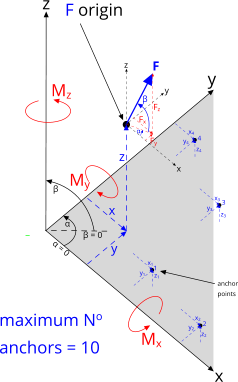Anchors

Fig 1. Multiple Anchors and a Single Load
An anchor is any fixing, to a foundation, deck or structure.
In all cases, an anchor is assumed (by CalQlata) to be stationary at the time a load is applied, including an anchor that may occasionally relocate. An anchor may be a bolt, weld or mechanical lock, but for any loadcase Anchors assumes that these fixings are rigid.
In this case, a single load is applied to a body or structure that is anchored with multiple (up to 10) fixings. The load and the anchors are located relative to 'x,y,z' co-ordinate 0,0,0. The single load, which may be applied at any angle and location, is resolved into x,y,z components (Fx, Fy & Fz), which applies to the entire structure. Therefore, these forces are [theoretically] shared equally between each fixing. However, whilst such an assumption may be perfectly valid for welded fixings, it may not be so for bolted or mechanical locks, either of which may be subject to differential strains or clearances. It is up to the designer to apply a suitable application factor to ensure an acceptable level of safety. For example; 5 fixings subjected to a force (F) may be shared as follows:
welded; F/4 (assume one failure)
bolted; F/3 (assume greater strain in bolts with higher moments)
mechanical lock; F/2.5 (assume not all locks are coincidently rigid).
For multiple loads applied to a single fixing (anchor), please use CalQlata's Anchor calculator.
Each applied load will induce individual force vectors ('Fx, Fy, Fz') and moments ('Mx, My, Mz') about each anchor. Where multiple forces are applied to multiple anchors, compound values may be derived by copying and pasting the results from this calculator into a spreadsheet and adding them together.
To the forces calculated here must be added the weight of the structure with similar applications factors (see above).
Structural or deck strength may then be established from these force vectors and moments.

Fig 2. Co-ordinate System 'y'
Anchors Calculator – Technical Help
The most popular co-ordinate systems are either where the y-axis points vertically upwards Fig 2, or where the z-axis points vertically upwards (Fig 3).
In both cases, the forces and moments at the origin (0,0,0) will be identical, but the input and output designations will differ.
In Anchors, you may enter your input data using either system, you simply need to be careful with your directions and angles.
Irrespective of the system used, Anchors will reorientate the input data when switching between options.
Units
You may use any units you like, but you should be consistent; remember you will only get out whatever you put in.
Metric and Imperial units are provided {metric, Imperial} below for information only.
Input Data

Fig 3. Co-ordinate System 'z'
The following input data applies to, and is repeated for, each applied load; 1 to 10:
F (force): The applied load {N, lb}
α (angle): The angle of rotation about the vertical axis ('y' or 'z') {°}
β (angle): The vertical angle of rotation from the horizontal plane ('x,z' or 'x,y') {°}
x (distance): The distance to origin of 'F' in direction 'x' from co-ordinate 0,0,0 {m, ft}
y (distance): The distance to origin of 'F' in direction 'y' from co-ordinate 0,0,0 {m, ft}
z (distance): The distance to origin of 'F' in direction 'z' from co-ordinate 0,0,0 {m, ft}
xₐ (distance): The distance to anchor (1 to 10) in direction 'x' from co-ordinate 0,0,0 {m, ft}
yₐ (distance): The distance to anchor (1 to 10) in direction 'y' from co-ordinate 0,0,0 {m, ft}
zₐ (distance): The distance to anchor (1 to 10) in direction 'z' from co-ordinate 0,0,0 {m, ft}
Output Data
The following output data is the solution from all of the input data combined and resolved into ...
... the total force in the anchor at co-ordinate 0,0,0:
Fx (force): in direction 'x' {N, lb}
Fy (force): in direction 'y' {N, lb}
Fz (force): in direction 'z' {N, lb}
... the moments at co-ordinate origin 0,0,0:
Mx (0) (moment): about the 'x-axis' {N.m, lb.ft}
My (0) (moment): about the 'y-axis' {N.m, lb.ft}
Mz (0) (moment): about the 'z-axis' {N.m, lb.ft}
... the moments in anchor (1 to 10) relative to co-ordinate 0,0,0:
Mx (1 to 10) (moment): about the 'x-axis' {N.m, lb.ft}
My (1 to 10) (moment): about the 'y-axis' {N.m, lb.ft}
Mz (1 to 10) (moment): about the 'z-axis' {N.m, lb.ft}
Applicability
This calculator applies to any structure attached to a foundation, deck or structure with anchors to which a single load is applied. Anchors may be any size or shape, but the output data will be valid at the centre of the anchor's second moment of area. See also CalQlata's Anchor calculator.
Accuracy
The output data from this calculator is as accurate as the input data.
Further Reading
You will find further reading on this subject in reference publications(3 & 12)

